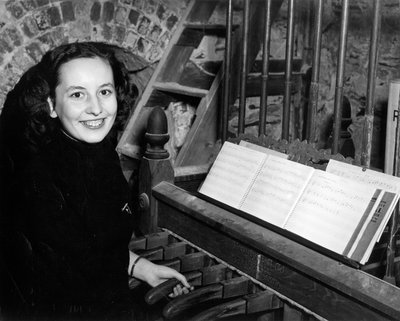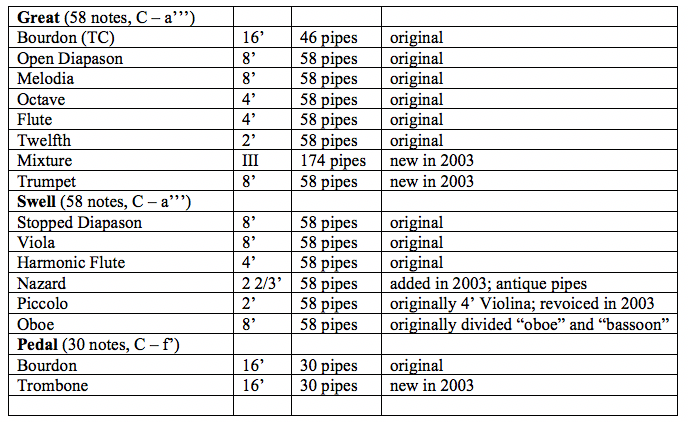Goddard Chapel Instruments
Wednesday, May, 1st, 2019 Past Announcements

Chime ringer in Goddard Chapel, 1948
The Carillon
A carillon is a set of tuned bells arranged so that music can be played on them. The 25 carillon bells were donated at three different times. The first bell was given by the class of 1898 on their tenth reunion in 1908. In 1926, Eugene Bowen donated nine bells. In 1966, a further fifteen bells and the first carillon mechanism were donated in honor of the first provost of Tufts University, John Tilton. Today, the 25 bells (F, G, then A to g’ chromatically) are playable from an electronic keyboard console made by the Verdin company of Cincinatti, Ohio, which also enables the recording of anything from a sequence of chimes to an elaborate tune. Usually the carillon plays a hymn tune at 5:00pm daily, which is chosen and recorded monthly by the music director of the chapel.
The Organ
The chapel organ is original to the space and was dedicated at the same time as the building in 1883. While it has undergone maintenance and restoration (most recently in 2003) the tonal specification has not been altered significantly from when it was new, and the few alterations were done in the style of the original instrument. The organ was designed, built, and installed by the Hook & Hastings firm of Weston, Massachusetts. Their largest and most conspicuous instrument was installed in the Cathedral of the Holy Cross in 1875. The Goddard Chapel organ has 976 pipes over sixteen stops and is a tracker organ, that is to say it is fully mechanical other than the wind being supplied by an electric blower.
The specification of the organ is as follows:

Couplers: Great to Pedal, Swell to Pedal, Swell to Great, Swell Octave to Great
Features: Great manual forte and piano registration with foot switches, typical of the maker.
The Piano
The piano in the chapel is from around 1985s, a 6’10 ½” model B grand from America’s most famous and well-respected piano maker, Steinway & Sons. It is an excellent instrument for accompanying worship as well as choirs, chamber music, and solo playing.
If you would like to know more about the instruments please contact Music Director Suzanne Cartreine at chaplaincymusic@tufts.edu.
Rules for Goddard Chapel Instruments - As of September 2023
Goddard Chapel is fortunate to be the home of three very beautiful — and in two cases historic — instruments. The carillon has been assembled from bells given to the chapel from 1908-1966; the Hook and Hastings organ was dedicated with the chapel in 1883 and it remains in a similar state to when it was first made. The Steinway “B” piano (c. 1985) is played during worship services, concerts, and special events. Please follow these simple rules to help ensure that these instruments continue to serve the community for many years to come.
- Permission to use the piano or organ should be sought at the time you make your request to book the space, or as soon thereafter as possible.
- Permission to use the piano or organ is granted by the Music Director or the University Chaplain.
- The piano has an attached Dampp Chaser – a humidity control system, which is fixed underneath the piano and must remain plugged in at all times. Please do not unplug it – use extension cords from other outlets to get the electricity you need. In the rare event that you need to move the piano or unplug it for some other reason, please make sure you plug it back in when you are done using the space.
- The keys to the piano and organ are in the key box in the office and any student staff in the chapel should be able to get them for you. When you are finished with your event, the instrument(s) should be locked and the key(s) returned to the student worker and key box.
- No food or drink is to be placed on the instruments at any time. The organ keys are old enough to be natural ivory and can stain; please wash your hands before playing, especially if you have been eating.
- Playing these instruments assumes a certain level of training and proficiency. If you are not sure that you have the skills required, please set up a time with the Music Director to play for them to be sure. This is not to assess your musical ability, but to determine whether you know how to treat the instruments with appropriate care.
- Accidents can happen, some of which have nothing to do with the player. If anything breaks or goes wrong, please stop playing right away and notify the University Chaplaincy Office and the Music Director so that we can determine if further use will do damage to the instrument and we can schedule the necessary repair as soon as possible.
- The carillon is controlled via a keyboard console, and therefore can be played by any pianist/keyboardist. If you wish to play the carillon, please schedule a brief walkthrough of how to use it with the Music Director.
Thank you for taking the time to read these rules. If you have any further questions, please do not hesitate to ask at chaplaincymusic@tufts.edu.